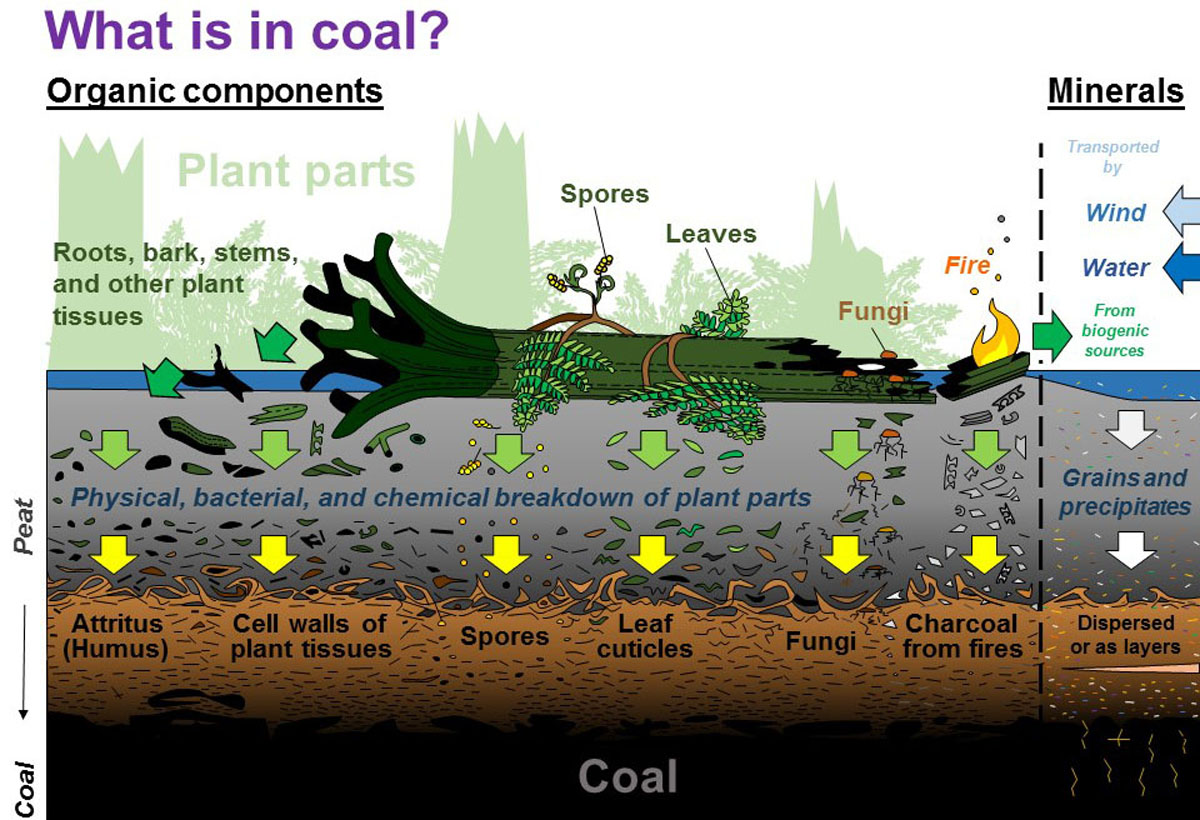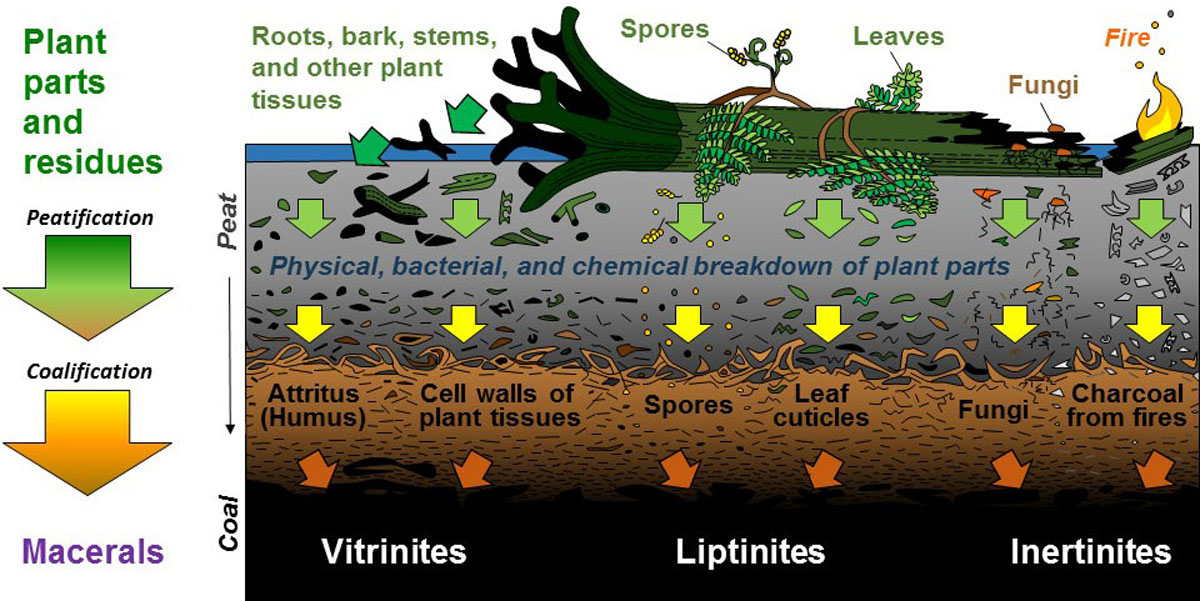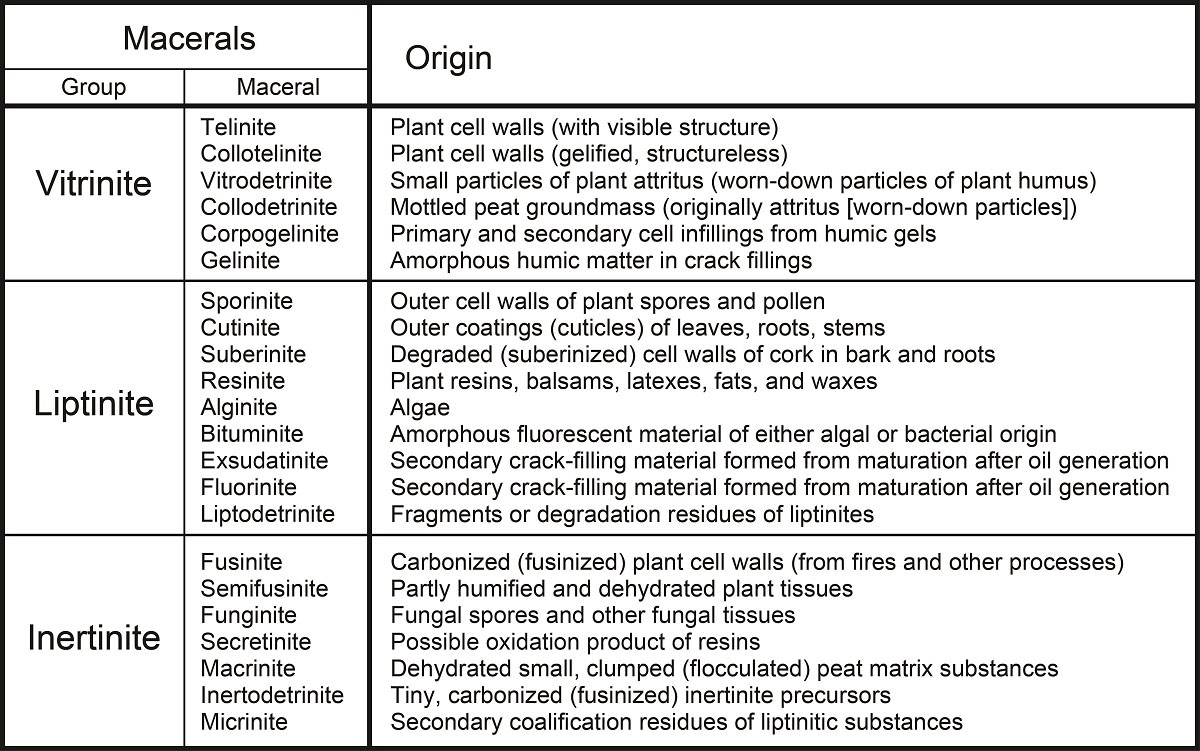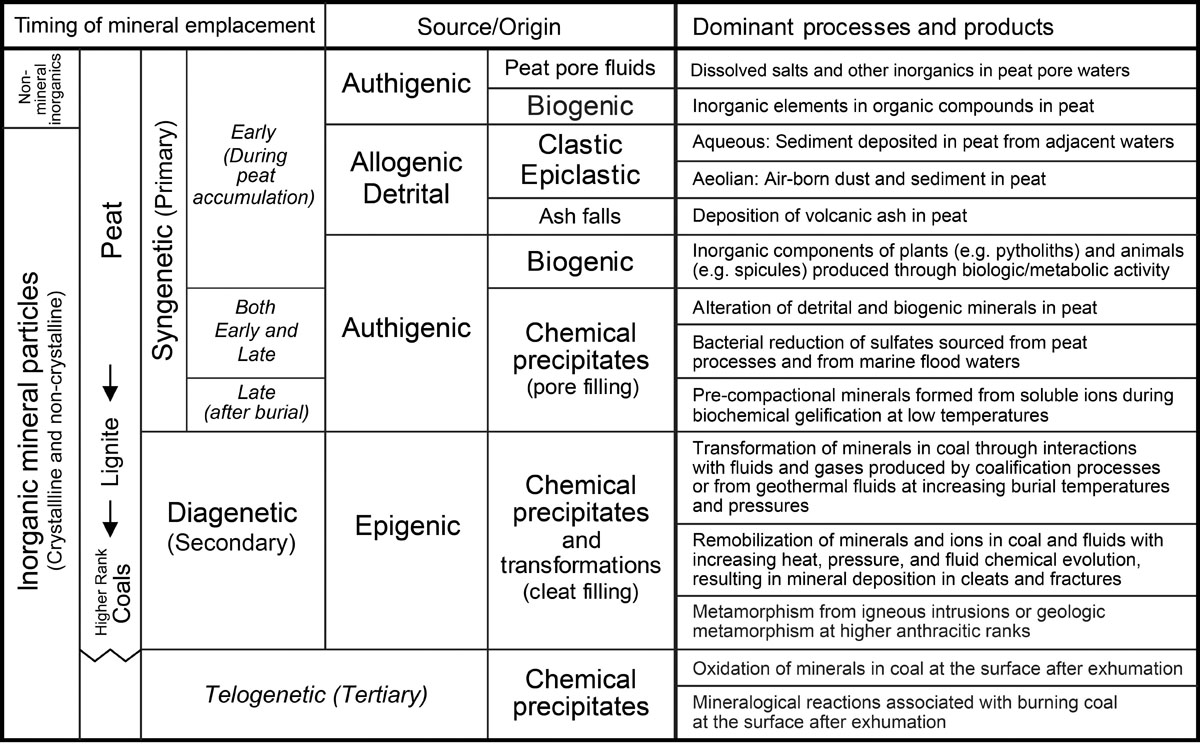Which Are the Components of Coal?
by Rudy P. SysAdmin at howtofindthemoneyCoal beds are composed of coal bands or layers sometimes separated by thin sedimentary rock layers (usually shale) called partings. Coal bands are described as types and lithotypes. Coal bands are formed from peat, which is mostly composed of plant debris with some amount of minerals. The thin sediment partings in most coals form when the original coal-forming peats are flooded, but at least one parting in Kentucky formed from volcanic ash that fell in the coal-forming peat.
Coal types and lithotypes are composed of altered plant parts such as roots, leaves, stems, and spores. Through the process of peatification and then coalification, distinctive plant parts partially decompose and are altered into tiny organic particles and gels called macerals. The coal-forming peat and subsequent coal also contain disseminated inorganic particles, called minerals. The proportion and types of macerals and minerals in a coal bed influence its quality and how it can be used.

Macerals
On the microscopic level, coal is made up of organic particles called macerals. Macerals are the altered remains and byproducts of the original plant material from which the coal-forming peat originated. Macerals are to coal as sediment grains and cements are to sedimentary rocks.
Coal petrographers (people who study coal under a microscope) separate macerals into three groups, each of which includes several maceral types. The groups are inertinite, liptinite, and vitrinite. These groups were defined according to their grayness in reflected light under a microscope. Liptinites are dark gray, vitrinites are medium to light gray, and inertinites are white and can be very bright.

Microscopic macerals in coal are derived from plants and plant residues.
Different macerals are formed from different plant parts or different residues of bacterially, chemically, or physically broken-down plant parts. Different maceral groups, and individual macerals, have different chemical compositions that, in total, influence the chemical composition of the resulting coal (Stach and others, 1982; Bustin and others, 1983; Teichmüller, 1989).

Maceral groups and macerals in subbituminous, bituminous. and anthracitic coals, and their origins. Some of the macerals are the same for low-rank lignite coals, but there are different maceral groups and additional macerals for lignites.
Liptinites are derived from spores, pollens, cuticles, and resins in the original plant material. These plant parts are more hydrogen-rich than other macerals. They are also fluorescent at some coal ranks.
Vitrinites are composed of partially "gelled" wood, bark, and roots, and contain less hydrogen than liptinites.
Inertinites are mainly oxidation products of other macerals and are consequently richer in carbon than liptinites or vitrinites, because much of the oxygen in the original plant parts or residues has been consumed by oxidation. The inertinite group includes fusinite (most of which is fossil charcoal) derived from ancient fires in the coal-forming peat (see, for example, Scott, 1989). Other inertinite macerals ( for example, macrinite) owe their origin to biological decomposition and decay of plant material (Hower and others, 2009). Still others ( for example, micrinite) result from thermal maturation of the peat.
Mineral Matter
Coal also contains minerals, which mostly occur as inorganic crystalline and noncrystalline particles or masses. A coal seam may consist of as much as 50 percent minerals. At more than 50 percent mineral matter, the rock would be termed a carbonaceous shale rather than coal. Most mined coals are less than 20 percent mineral matter, and many coal contracts require less than 10 percent ash yield, which is approximately (but generally less than) the actual mineral matter content of a coal. More than 120 minerals and inorganic compounds have been documented in coals worldwide (Finkelman, 1981; Vassilev and Vassileva, 1996; Ward, 2002; Schweinfurth and Finkelman, 2003).
Minerals in coal can be divided into two broad categories: (1) minerals that originated in the original coal-forming peat, termed syngenetic or primary minerals, and (2) diagenetic or secondary minerals, which were introduced into the coal, remobilized in the coal, or transformed from other minerals in the coal at any time after the original coal-forming peat was buried. Some minerals can also form in coal by oxidation of sulfides and other minerals when the coal is exposed at the surface. These would be termed tertiary minerals. Most tertiary minerals are transformations of minerals that are already in the coal (Mackowsky, 1982; Renton, 1982; Vassilev and Vassileva, 1996; Ward, 2002).

Mineral matter in coal showing terms used for the origin of minerals in coal.
Syngenetic minerals tend to be tiny (microns) particles embedded in the coal matrix. Biogenic sources of syngenetic minerals include plants and organisms in the original coal-forming peats. Many plants incorporate minerals into their structures. An example of this is the common horsetail, or scouring rush, which incorporates silica in its tissues to provide structural strength. Some organism that live in, or are transported into peats, or whose remains are transported into peats also contain minerals in their body structures (see for example, Andrejko and others, 1983).
Detrital, syngenetic minerals include clays and other sediments transported into the coal-forming peats during floods. Detrital minerals also include dust and silt carried into the peat by wind. Thick, concentrated detrital sediments form rock partings in coal. Finer, less-concentrated sediment input is disseminated into the coal-forming peat without a visible rock laminae or bed.
A wide array of chemical precipitates may also occur in peat through various processes involved in peatification, including the bacterial reduction of sulfates in peat pore waters.
Once a peat is buried, mineral introduction and transformation is said to be diagenetic. Diagenetic minerals tend to be more coarsely crystalline than syngenetic minerals. After coal has reached the lignite stage, diagenetic minerals tend to occur as thicker concentrations in cleat and fracture fills, which are visible to the naked eye. This distinction is significant, because cleat-filling minerals are easier to remove from coal than from syngenetic, authigenic minerals (Rao and Gluskoter, 1973; Mackowsky, 1982; Renton, 1982; Ward, 1989; van Krevelen, 1993).
The amount, particle size, and type of mineral matter in coal influences a wide variety of uses, including combustion for steam for electrical energy production and the production of metallurgical coke to make steel. Understanding mineral components is not only important for the practical processes and maintenance of combustion equipment, but also because of the chemical reactions that occur during combustion, and the resultant composition of emissions and solid residues, especially in countries where the chemical composition of the emissions or residues is regulated.
Sponsor Ads
Created on Jul 10th 2019 04:14. Viewed 910 times.
Comments
No comment, be the first to comment.



